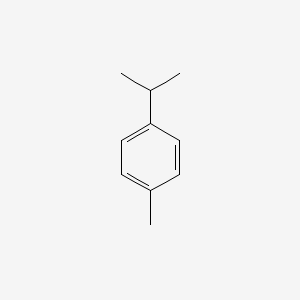| MeSH term | MeSH ID | Detail |
|---|---|---|
| Chemical and Drug Induced Liver Injury | D056486 | 39 associated lipids |
| Dermatomycoses | D003881 | 17 associated lipids |
| Carbon Tetrachloride Poisoning | D002252 | 12 associated lipids |
p-Cymene
P-cymene is a lipid of Prenol Lipids (PR) class. P-cymene is associated with abnormalities such as Abnormal shape. The involved functions are known as Binding (Molecular Function), inhibitors and Oxidation. P-cymene often locates in Cell membrane. The associated genes with p-Cymene are Chromatin, Homologous Gene and ethylbenzene dehydrogenase. The related lipids are Steroids.
Cross Reference
Introduction
To understand associated biological information of p-Cymene, we collected biological information of abnormalities, associated pathways, cellular/molecular locations, biological functions, related genes/proteins, lipids and common seen animal/experimental models with organized paragraphs from literatures.
What diseases are associated with p-Cymene?
p-Cymene is suspected in Abnormal shape and other diseases in descending order of the highest number of associated sentences.
Related references are mostly published in these journals:
| Disease | Cross reference | Weighted score | Related literature |
|---|
Possible diseases from mapped MeSH terms on references
We collected disease MeSH terms mapped to the references associated with p-Cymene
PubChem Associated disorders and diseases
What pathways are associated with p-Cymene
There are no associated biomedical information in the current reference collection.
PubChem Biomolecular Interactions and Pathways
Link to PubChem Biomolecular Interactions and PathwaysWhat cellular locations are associated with p-Cymene?
Visualization in cellular structure
Associated locations are in red color. Not associated locations are in black.
Related references are published most in these journals:
| Location | Cross reference | Weighted score | Related literatures |
|---|
What functions are associated with p-Cymene?
Related references are published most in these journals:
| Function | Cross reference | Weighted score | Related literatures |
|---|
What lipids are associated with p-Cymene?
Related references are published most in these journals:
| Lipid concept | Cross reference | Weighted score | Related literatures |
|---|
What genes are associated with p-Cymene?
Related references are published most in these journals:
| Gene | Cross reference | Weighted score | Related literatures |
|---|
What common seen animal models are associated with p-Cymene?
There are no associated biomedical information in the current reference collection.
NCBI Entrez Crosslinks
All references with p-Cymene
Download all related citations| Authors | Title | Published | Journal | PubMed Link |
|---|---|---|---|---|
| Affonso VR et al. | Influence of growth regulators in biomass production and volatile profile of in vitro plantlets of Thymus vulgaris L. | 2009 | J. Agric. Food Chem. | pmid:19601670 |
| Granzhan A et al. | Connection of metallamacrocycles via dynamic covalent chemistry: a versatile method for the synthesis of molecular cages. | 2011 | J. Am. Chem. Soc. | pmid:21495636 |
| LESTER CT and BAILEY CF | Studies in p-cymene; the saponification rate of isomeric benzoates derived from p-cymene. | 1946 | J. Am. Chem. Soc. | pmid:21015730 |
| Lo VK et al. | Highly selective intramolecular carbene insertion into primary C-H bond of α-diazoacetamides mediated by a (p-cymene)ruthenium(II) carboxylate complex. | 2012 | J. Am. Chem. Soc. | pmid:22530941 |
| Park BS et al. | Monoterpenes from thyme (Thymus vulgaris) as potential mosquito repellents. | 2005 | J. Am. Mosq. Control Assoc. | pmid:15825766 |
| Choi WS et al. | Repellent activities of essential oils and monoterpenes against Culex pipiens pallens. | 2002 | J. Am. Mosq. Control Assoc. | pmid:12542193 |
| Estell RE et al. | Effect of individual terpenes on consumption of alfalfa pellets by sheep. | 2000 | J. Anim. Sci. | pmid:10875647 |
| Papadopoulos CJ et al. | Susceptibility of pseudomonads to Melaleuca alternifolia (tea tree) oil and components. | 2006 | J. Antimicrob. Chemother. | pmid:16735435 |
| Juven BJ et al. | Factors that interact with the antibacterial action of thyme essential oil and its active constituents. | 1994 | J. Appl. Bacteriol. | pmid:8027009 |
| Gallucci MN et al. | In vitro activity of natural phenolic compounds against fluconazole-resistant Candida species: a quantitative structure-activity relationship analysis. | 2014 | J. Appl. Microbiol. | pmid:24387763 |
| Cox SD et al. | Interactions between components of the essential oil of Melaleuca alternifolia. | 2001 | J. Appl. Microbiol. | pmid:11556915 |
| Matan N et al. | Enhanced inhibition of Aspergillus niger on sedge (Lepironia articulata) treated with heat-cured lime oil. | 2013 | J. Appl. Microbiol. | pmid:23617888 |
| de Smet MJ et al. | Plasmid control of the Pseudomonas aeruginosa and Pseudomonas putida phenotypes and of linalool and p-cymene oxidation. | 1989 | J. Bacteriol. | pmid:2504698 |
| Wigmore GJ and Ribbons DW | p-Cymene pathway in Pseudomonas putida: selective enrichment of defective mutants by using halogenated substrate analogs. | 1980 | J. Bacteriol. | pmid:7204334 |
| Eaton RW | p-Cymene catabolic pathway in Pseudomonas putida F1: cloning and characterization of DNA encoding conversion of p-cymene to p-cumate. | 1997 | J. Bacteriol. | pmid:9150211 |
| Castellano-Castillo M et al. | Binding of mismatch repair protein MutS to mispaired DNA adducts of intercalating ruthenium(II) arene complexes. | 2008 | J. Biol. Inorg. Chem. | pmid:18491151 |
| Filak LK et al. | Organometallic indolo[3,2-c]quinolines versus indolo[3,2-d]benzazepines: synthesis, structural and spectroscopic characterization, and biological efficacy. | 2010 | J. Biol. Inorg. Chem. | pmid:20369265 |
| Rattanachaikunsopon P and Phumkhachorn P | Assessment of factors influencing antimicrobial activity of carvacrol and cymene against Vibrio cholerae in food. | 2010 | J. Biosci. Bioeng. | pmid:20638331 |
| Wang H et al. | Experience-induced habituation and preference towards non-host plant odors in ovipositing females of a moth. | 2008 | J. Chem. Ecol. | pmid:18253797 |
| Lapointe SL et al. | A Phagostimulant Blend for the Asian Citrus Psyllid. | 2016 | J. Chem. Ecol. | pmid:27542089 |
